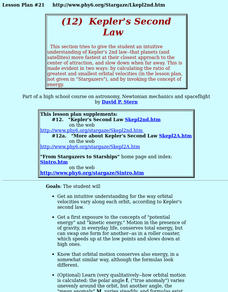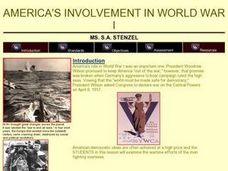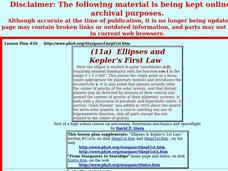Curated OER
The Discovery of the Solar System
Students explain the observed motion of the planets. The inner ones move back-and-forth across the position of the Sun, while the outer ones usually advance in one direction, but with occasional temporary reversals known as "retrograde...
Curated OER
Ellipses And Kepler's First Law
Learners explain that planets actually orbit the center of gravity of the solar system, and that distant planets may be detected by motions of their central star around the centers of gravity of their planetary systems.
Curated OER
The Path of the Sun, the Ecliptic
High schoolers are introduced to the ecliptic, the zodiac and the apparent motions of the Sun, Moon and planets across the sky.
Curated OER
Finding the Pole Star
Students study the constellations fo the Big Dipper and Cassiopeia and their use in finding the Pole Star. They realize that other celestial objects--Sun, Moon and planets--share the rotation (and hence rise and set), even though their...
Curated OER
Kepler's Second Law
Students gain an understanding of Kepler's 2nd law--that planets (and satellites) move fastest at their closest approach to the center of attraction, and slow down when far away. They explore the concepts of "potential energy" and...
Curated OER
Spelling and Thinking/ Short a
Students participate in a lesson that is concerned with the usage of spelling words that has the short "a" sound. They read the words in list form. Students also write the words in the "an" and "ad" word families.
Curated OER
America's Involvement in World War I
Students investigate online websites on German U-boat naval warfare, conditions in the trenches and the effects of poisonous gases. They write three entries in a diary from different perspectives.
Curated OER
Ellipses and Kepler's First Law
The class examines graphs in the form r = F(¿¿) in polar coordinates (r, ¿¿), in particular with the circle, ellipse and other conic sections. They determine the nature of an ellipse by studying the role of the semimajor axis and...
Curated OER
Kepler's 3rd Law
Learners derive the velocity in a circular orbit of any radius. They derive the Earth escape velocity and prove Kepler's 3rd law for circular orbits # A simple formula for the orbital period in a circular Earth orbit of given radius.
Main Memory Network
Longfellow's "The Village Blacksmith" and Whitman's "Song of Myself"
Although the work Americans do has changed over time, the plight of the American worker has largely remained the same. Facilitate a class discussion aboutAmerican workers using Henry Wadsworth Longfellow's "The Village Blacksmith" and...
Curated OER
Kepler's Third Law
High schoolers use Kepler's third law to derive the velocity in a circular orbit of any radius, and identify the Earth escape velocity.
Curated OER
Momentum
Students learn the concepts of momentum and its conservation, using the recoil of a cannon as an example. They examine how momentum is a vector, allowing its conservation to be applied to problems in 2 and 3 dimensions.
Curated OER
The Path of the Sun: The Ecliptic
Pupils investigate the celestial sphere and the paths it takes in the solar system.
Curated OER
The Celestial Sphere
High schoolers are introduced to the celestial sphere, describing its apparent rotation and the special role of the pole star.
Curated OER
Kepler's Second Law
Students explore orbital velocities and how they vary along each orbit, according to Kepler's Second Law.
Curated OER
What Have You Learned about the Mouth?
Learners sequence the steps in a normal day that can lead to tooth decay and describe how to maintain a healthy mouth.
Curated OER
Will It Rain Today or Tomorrow?
Learners examine how to forecast weather. They examine the different types of weather and learn the correct vocabulary.


















